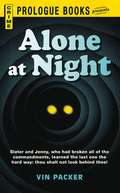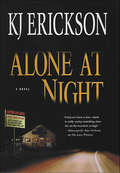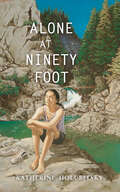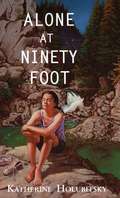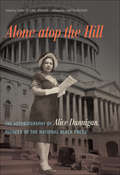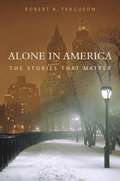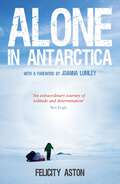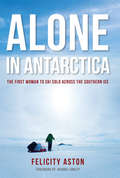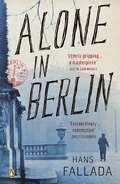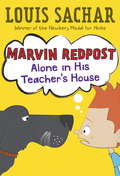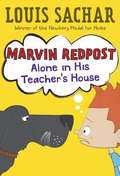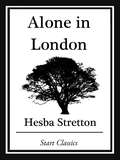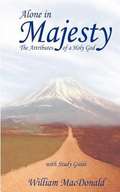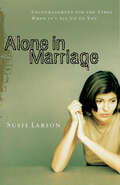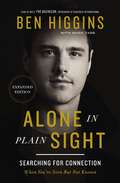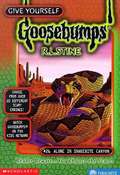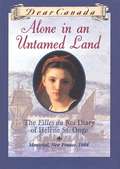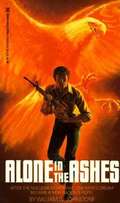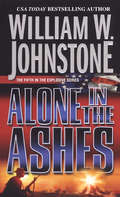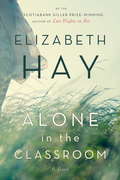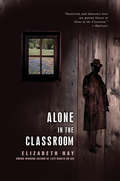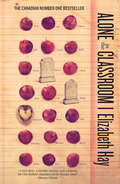- Table View
- List View
Alone at Night
by Vin PackerOn their first night Carrie had been nervous, and Slater had tried to think of some way to make it easier for her, to show her how fine and free it could be. But the moment they’d stepped into the cabin, she had undressed, matter-of-factly, a cigarette dangling from her lips. Her body was white and incredibly lovely, and Slater had felt desire engulf him. He had held her, hungrily, and hardly listed to the one thing she’d said. ''I don’t think I’ll be much good at this.'' She had been so cruelly right. And that, in a way, was what had killed her. That, and a beautiful woman named Jenny.
Alone at Night: A Novel (Mars Bahr Mysteries)
by K.J. EricksonTired of the politics, publicity and endless nights that go with major homicides, Detective Mars Bahr and his partner Nettie Frisch have moved to the Cold Case Unit, which covers the Minneapolis Police Department's oldest unsolved cases. One of their first assignments is tackling the murders of rural convenience store employees, which leads them to a sixteen-year-old missing persons case.In 1986, seventeen-year-old Andrea Bergstad was working alone at night at a rural Minnesota gas station when she vanished without a trace. On the store's fuzzy security videotape, one minute she's there, talking on the phone to her best friend, and the next she's gone. Now, sixteen years later, Mars goes back to Redstone, Minnesota, to try to put together the pieces of this baffling case.In Redstone, Mars meets retired sheriff Sig Sampson, off the job for several years but haunted by the Bergstad case like it was yesterday. Sig Sampson is the only person who can help Mars do what needs to be done in order to solve it: His memory is the only thing that can take this cold case and make it hot.Mars and Sig dive into the investigation, and Mars soon begins to think that their hard work will get them somewhere. But his concern over the details distracts him from the greater issues in the case, and before he knows it, the lives of the two most important people in Mars' life are at risk.As with her most recent acclaimed novel, The Last Witness, KJ Erickson delivers a fast-paced, engaging, and surprising thriller.
Alone at Ninety Foot
by Katherine HolubitskyFourteen-year-old Pamela Collins is struggling to come to terms with her mother's death. Somewhat shy, Pamela is thoughtful, full of passion, often funny, and sometimes tearful as she learns to cope with the emotional overload the tragedy has brought to her life. Her favourite things include walking alone in Lynn Canyon Park, the art of Emily Carr, and a certain boy with a "wicked grin." At the moment she dislikes her English teacher, shopping, and being singled out for special treatment because of her motherís death. Pamela is tall and slim and mostly uncomfortable with her rapidly changing body. She is unsure of herself and unsure of the loyalty of her friends.
Alone at Ninety Foot (Orca Books)
by Katherine HolubitskyA realistic portrait of a young girl's struggle to come to terms with her mother's death.
Alone at the Altar: Single Women and Devotion in Guatemala, 1670-1870
by Brianna Leavitt-AlcántaraBy 1700, Guatemala's capital was a mixed-race "city of women." As in many other cities across colonial Spanish America, labor and migration patterns in Guatemala produced an urban female majority and high numbers of single women, widows, and female household heads. In this history of religious and spiritual life in the Guatemalan capital, Brianna Leavitt-Alcántara focuses on the sizeable population of ordinary, non-elite women living outside of both marriage and convent. Although officials often expressed outright hostility towards poor unmarried women, many of these women managed to position themselves at the forefront of religious life in the city. Through an analysis of over 500 wills, hagiographies, religious chronicles, and ecclesiastical records, Alone at the Altar examines how laboring women forged complex alliances with Catholic priests and missionaries and how those alliances significantly shaped local religion, the spiritual economy, and late colonial reform efforts. It considers the local circumstances and global Catholic missionary movements that fueled official collaboration with poor single women and support for diverse models of feminine piety. Extending its analysis past Guatemalan Independence to 1870, this book also illuminates how women's alliances with the Catholic Church became politicized in the Independence era and influenced the rise of popular conservatism in Guatemala.
Alone atop the Hill: The Autobiography of Alice Dunnigan, Pioneer of the National Black Press (A\sarah Mills Hodge Fund Publication)
by Alice DunniganThe memoir of &“the first African American female reporter to gain entry into the closed society of the White House and congressional news correspondents&” (Hank Klibanoff, coauthor of the Pulitzer Prize-winning The Race Beat). In 1942 Alice Allison Dunnigan, a sharecropper&’s daughter from Kentucky, made her way to the nation&’s capital and a career in journalism that eventually led her to the White House. With Alone Atop the Hill, Carol McCabe Booker has condensed Dunnigan&’s 1974 self-published autobiography to appeal to a general audience and has added scholarly annotations that provide historical context. Dunnigan&’s dynamic story reveals her importance to the fields of journalism, women&’s history, and the civil rights movement and creates a compelling portrait of a groundbreaking American. Dunnigan recounts her formative years in rural Kentucky as she struggled for a living, telling bluntly and simply what life was like in a Border State in the first half of the twentieth century. Later she takes readers to Washington, D.C., where we see her rise from a typist during World War II to a reporter. Ultimately she would become the first black female reporter accredited to the White House; authorized to travel with a U.S. president; credentialed by the House and Senate Press Galleries; accredited to the Department of State and the Supreme Court; voted into the White House Newswomen&’s Association and the Women&’s National Press Club; and recognized as a Washington sports reporter. In Alone Atop the Hill, &“Dunnigan&’s indelible self-portrait affirms that while the media landscape has changed, along with some social attitudes and practices, discrimination is far from vanquished, and we still need dedicated and brave journalists to serve as clarion investigators, witnesses, and voices of conscience (Booklist, starred review).
Alone in America
by Robert A. FergusonRobert A. Ferguson investigates the nature of loneliness in American fiction, from its mythological beginnings in Rip Van Winkle to the postmodern terrors of 9/11. At issue is the dark side of a trumpeted American individualism. The theme is a vital one because a greater percentage of people live alone today than at any other time in U. S. history. The many isolated characters in American fiction, Ferguson says, appeal to us through inward claims of identity when pitted against the social priorities of a consensual culture. They indicate how we might talk to ourselves when the same pressures come our way. In fiction, more visibly than in life, defining moments turn on the clarity of an inner conversation. Alone in America tests the inner conversations that work and sometimes fail. It examines the typical elements and moments that force us toward a solitary state-failure, betrayal, change, defeat, breakdown, fear, difference, age, and loss-in their ascending power over us. It underlines the evolving answers that famous figures in literature have given in response. Figures like Mark Twain’s Huck Finn and Toni Morrison’s Sethe and Paul D. , or Louisa May Alcott’s Jo March and Marilynne Robinson’s John Ames, carve out their own possibilities against ruthless situations that hold them in place. Instead of trusting to often superficial social remedies, or taking thin sustenance from the philosophy of self-reliance, Ferguson says we can learn from our fiction how to live alone.
Alone in Antarctica: The Classic True Story of One Woman's Solo Journey Across Antarctica
by Felicity Aston Joanne LumleyAt the age of 34, Felicity Aston became the first woman to cross Antarctica alone. Frozen into her facemask, she battled desperate weather and raced to reach the coast before the last flight out. This gripping and inspirational account shows what you can achieve when you grit your teeth and decide just to get through today in one piece.
Alone in Antarctica: The Classic True Story of One Woman's Solo Journey Across Antarctica
by Felicity Aston Joanne LumleyAt the age of 34, Felicity Aston became the first woman to cross Antarctica alone. Frozen into her facemask, she battled desperate weather and raced to reach the coast before the last flight out. This gripping and inspirational account shows what you can achieve when you grit your teeth and decide just to get through today in one piece.
Alone in Antarctica: The First Woman to Ski Solo Across the Southern Ice
by Felicity AstonIn the whirling noise of our advancing technological age, we are seemingly never alone, never out-of-touch with the barrage of electronic data and information.Felicity Aston, physicist and meteorologist, took two months off from all human contact as she became the first woman -- and only the third person in history - to ski across the entire continent of Antarctica alone. She did it, too, with the simple apparatus of cross-country, without the aids used by her prededecessors - two Norwegian men - each of whom employed either parasails or kites.Aston's journey across the ice at the bottom of the world asked of her the extremes in terms of mental and physical bravery, as she faced the risks of unseen cracks buried in the snow so large they might engulf her and hypothermia due to brutalizing weather. She had to deal, too, with her emotional vulnerability in face of the constant bombardment of hallucinations brought on by the vast sea of whiteness, the lack of stimulation to her senses as she faced what is tantamount to a form of solitary confinement.Like Cheryl Strayed's Wild, Felicity Aston's Alone in Antarctica becomes an inspirational saga of one woman's battle through fear and loneliness as she honestly confronts both the physical challenges of her adventure, as well as her own human vulnerabilities.
Alone in Berlin (Forsyte chronicles)
by Michael Hofmann Hans FalladaOtto, an ordinary German living in a shabby apartment block, tries to stay out of trouble under Nazi rule. But when he discovers his only son has been killed fighting at the front he's shocked into an extraordinary act of resistance, and starts to drop anonymous postcards attacking Hitler across the city. If caught, he will be executed. Soon this silent campaign comes to the attention of ambitious Gestapo inspector Escherich, and a murderous game of cat-and-mouse begins. Who loses, pays with their life.
Alone in His Teacher's House
by Louis Sachar Barbara SullivanIllus. in black-and-white. Marvin's friends think he's the luckiest boy in the world when his teacher asks him to dog-sit for a week. He gets to be alone in Mrs. North's house! But pretty soon it starts to look as if Marvin is not so lucky after all...."From the Trade Paperback edition.
Alone in His Teacher's House (Marvin Redpost #4)
by Louis SacharThe good thing Marvin has going will take him by surprise and help him to grow up. His teacher has picked him as her most responsible student, the boy she can trust to feed and pay attention to her dog, Waldo, and walk him 3 times a day while she's out of town for a week. He'll earn $25. <P><P>Waldo is lovable, Marvin is proud of his first job, its cool looking around at his teacher's things, his older brother admires him, His parents support him, and little sister Lindsey loves playing with Waldo. <P><P>This job should be easy but Marvin has problems. Waldo doesn't want to eat; his special care makes Marvin late to school. The sub labels Marvin a trouble maker and picks on him. And Marvin's friends think he's stuck up because he won't let them play in his teacher's house. After he's done his very best, his teacher won't be happy when she gets home. She might even hate Marvin. He cries and can't sleep. No one can help him. He must face his teacher and tell her everything. <P><P>This is a quick reading chapter book. Marvin finds that being mature means making decisions by himself; should he let his friends inside their teacher's house to see what she has in there? Should he let them play with Waldo? Should he call his parents or the vet for help? Should he eat dog food? Listen to your child read these short chapters written on second grade level but of interest to kids up to 6th grade. <P><P>Enjoy the humor together and help your child understand Marvin's frustration when he learns that being trustworthy sometimes means making his friends mad and that there is joy, worry and sorrow in caring for an old, lovable, pet. 3 other delightful Marvin Redpost books are in the collection. The book also contains a long list of other popular high interest, low vocabulary stepping stone books.
Alone in London
by Hesba StrettonAlone in London is presented here in a high quality paperback edition. This popular classic work by Hesba Stretton is in the English language, and may not include graphics or images from the original edition. If you enjoy the works of Hesba Stretton then we highly recommend this publication for your book collection.
Alone in Marriage: Encouragement for the Times When It's All Up to You
by Susie LarsonBooks abound for those whose marriages are crumbling or have ended. But what about those marriages committed "'til death do us part" and yet are going through a period of time when one spouse is carrying the burden? What happens to a woman when marriage gets heavy and she gets weary? Often, when a woman ends up carrying the weight of the marriage (due to her husband's health, choices, workload, etc.), her tendency is to "get out or check out." She may consider her husband's distraction an opportunity to do her own thing. But is there a better way to walk through this season? Even thrive?Susie Larson stands in as an encouraging friend, walking with you, helping you to discern how anxiety and anger will slow you down; and how loneliness and disappointment can actually refine and bless you. You will be challenged and inspired as you wrap your arms around this time and remember that God has His arms around you.
Alone in Marriage: Encouragement for the Times When It's All Up to You
by Susie LarsonBooks abound for those whose marriages are crumbling or have ended. But what about those marriages committed "'til death do us part" and yet are going through a period of time when one spouse is carrying the burden? What happens to a woman when marriage gets heavy and she gets weary? Often, when a woman ends up carrying the weight of the marriage (due to her husband's health, choices, workload, etc.), her tendency is to "get out or check out." She may consider her husband's distraction an opportunity to do her own thing. But is there a better way to walk through this season? Even thrive?Susie Larson stands in as an encouraging friend, walking with you, helping you to discern how anxiety and anger will slow you down; and how loneliness and disappointment can actually refine and bless you. You will be challenged and inspired as you wrap your arms around this time and remember that God has His arms around you.
Alone in Plain Sight Expanded Edition: Searching for Connection When You're Seen but Not Known
by Ben HigginsAre you tired of people knowing who you are but no one really knowing you?As the star of the twentieth season of The Bachelor, Ben Higgins looked like he had it all together. Instead, Ben felt dissatisfied, fearful, and deeply alone. Like so many of us, he thought of himself as the kid who never got picked for the game, the person always on the outside of the joke, the friend who knew a lot of people but was never truly known. He wondered if he mattered at all.In this expanded edition of Alone in Plain Sight, Ben shares with inspiring vulnerability how he found the deeper connection he longed for. He offers insight onhow to understand ourselves more deeply so that we are free to connect with others;how shared pain can bridge even the widest gaps between two very different people;how marriage and fatherhood have shaped his understanding of vulnerability and connection;how the God who longs for relationship with us is the answer to our need for connection; andin an all-new chapter, how radical generosity, service, and community building can lead to an even greater depth of relationship. In a disconnected world, it is possible to have lasting purpose and peace. You are already known. You are already loved. You are already seen. Discover how to live out how much you matter as you embrace the true meaning of your one incredible life.
Alone in Snakebite Canyon (Give Yourself Goosebumps #29)
by R. L. StineWant to be an eagle? Or a bear? Or a fish? Then check out the souvenir shop in Snakebite Canyon. They've got a pair of dried-up snake eyes with the power to turn you into a real animal. Maybe you'd like to buy a map of the lost gold mine. You could strike it rich. Or you could get attacked by a giant kid-eating spider! The choice is yours in this scary adventure that's packed with over 20 super-spooky endings.
Alone in an Untamed Land: The Diary of Hélène St. Onge
by Maxine TrottierHélène's future becomes uncertain when Catherine falls ill and dies on the crossing. She decides to take her sister's place, although her friendship with Kateri, a half-native girl, and Kateri's father give her a taste of early race relations.
Alone in the Ashes
by William W. JohnstoneThe Great War of '88 was a nuclear nightmare. America was shattered and only one man, Ben Raines, the famed soldier and survival expert, had the knowledge and the guts to build a new society.
Alone in the Ashes (Ashes #5)
by William W. JohnstoneA lone mercenary must fend for himself against gangs of bloodthirsty thugs in a post-apocalyptic wasteland—from a USA Today–bestselling author. While those who survived the bombs, the fallout, and the germ warfare struggle to stay alive in a world gone mad, legendary soldier and survival expert Ben Raines is fighting to rebuild a nation out of anarchy and bitter chaos. In this hellish new order, there are devils leading armed gangs of marauders. Under monikers like Cowboy Vic and Texas Red, they wreak destruction wherever they go. When Raines is cut off from his SUSA Rebel forces, he becomes their prey—a special target for their frenzy and bloodlust. From Georgia to West Texas and Colorado to Idaho, Raines must stay one step ahead of death…until he decides it's time to turn and fight. Fifth in the long-running series!
Alone in the Classroom
by Elizabeth HayIn a small prairie school in 1929, Connie Flood helps a backward student, Michael Graves, learn how to read. Observing them and darkening their lives is the principal, Parley Burns, whose strange behaviour culminates in an attack so disturbing its repercussions continue to the present day.Connie's niece, Anne, tells the story. Impelled by curiosity about her dynamic, adventurous aunt and her more conventional mother, she revisits Connie's past and her mother's broken childhood. In the process, she unravels the enigma of Parley Burns and the mysterious (and unrelated) deaths of two young girls. As the novel moves deeper into their lives, the triangle of principal, teacher, student opens out into other emotional triangles - aunt, niece, lover; mother, daughter, granddaughter - until a sudden, capsizing love thrusts Anne herself into a newly independent life. This spellbinding tale - set in Saskatchewan and the Ottawa Valley - crosses generations and cuts to the bone. It probes the roots of obsessive love and hate, how the hurts and desires of childhood persist and are passed on as if in the blood. It lays bare the urgency of discovering what we were never told about the past. And it celebrates the process of becoming who we are in a world full of startling connections that lie just out of sight.Following her award-winning, #1 bestselling Late Nights on Air, Alone in the Classroom is Elizabeth Hay's most intricate, compelling, and seductive novel yetFrom the Hardcover edition.
Alone in the Classroom
by Elizabeth HayHay is the winner of the prestigious Scotiabank Giller Prize, the Ottawa Book Prize, and the Libris Award for Fiction Book of the Year for her novel Late Nights on Air. Hay's fourth novel, Alone in The Classroom is a Globe and Mail Best Book. In a small prairie school in 1929, Connie Flood helps a struggling student, Michael Graves, learn how to read. Observing them and darkening their lives is the principal, Parley Burns, whose strange behavior culminates in an attack so disturbing its repercussions continue to the present day. Connie's niece, Anne, tells the story. Impelled by curiosity about her dynamic, adventurous aunt and her more conventional mother, she revisits Connie's past and her mother's broken childhood. In the process she unravels the enigma of Parley Burns and the mysterious, and unrelated, deaths of two young girls. As the novel moves deeper into their lives, the triangle of principal, teacher, student opens out into other emotional triangles--aunt, niece, lover; mother, daughter, granddaughter--until a sudden, capsizing love thrusts Anne herself into a newly independent life. This spellbinding tale--set in Saskatchewan and the Ottawa Valley--crosses generations and cuts to the bone. It probes the roots of obsessive love and hate, how the hurts and desires of childhood persist and are passed on, as if in the blood. It lays bare the urgency of discovering what we were never told about the past. And it celebrates the process of becoming who we are in a world full of startling connections that lie just out of sight. From the Hardcover edition.
Alone in the Classroom
by Elizabeth HayIn a small prairie school in 1929, Connie Flood helps a backward student, Michael Graves, learn how to read. Observing them and darkening their lives is the principal, Parley Burns, whose strange behaviour culminates in an attack so disturbing its repercussions continue to the present day. Connie's niece, Anne, tells the story. Impelled by curiosity about her dynamic, adventurous aunt and her more conventional mother, she revisits Connie's past and her mother's broken childhood. In the process she unravels the enigma of Parley Burns and the mysterious, and unrelated, deaths of two young girls.
